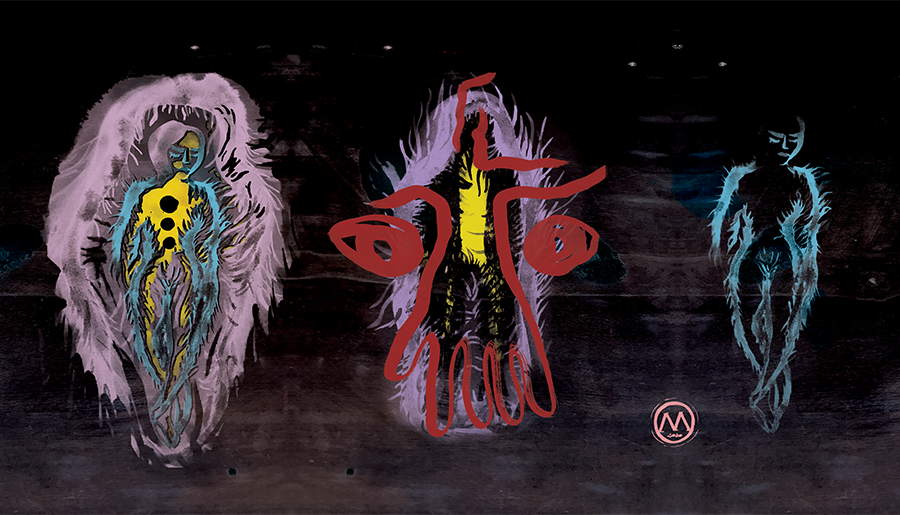Dreaming has various purposes, of course, the primary one is energy regeneration, but it could also lead to spiritual development. Dreams very often cause a spiritual awakening. Dreams can provide powerful insights to heal the body, mind, and spirit, overcome life’s challenges, and evolve. Exploring your dreams opens the door to a new connection with yourself and is a powerful capacity for inner self-knowledge. This is the work you have to do to bring the wisdom of your soul to the light.
In this article you will learn about the most important methods of working with dreams:
- shamanic journeys,
- a dream journal,
- dream appreciation,
- working with liminal dreams,
- method of active imagination,
- interview with yourself,
- dream bridge,
- dream yoga, sleep yoga, and Nidra yoga,
- Jung’s dream analysis.
Deep down you always know what your dream is about, but the knowledge is so vague that you need a method to get into it. The most popular methods of working with sleep are:
Shamanic Journeys or Shamanic Practices.
These practices are about realizing dreams and discovering them in all possible ways as if they came from a different reality. Traditionally, these methods have been associated with the use of hallucinogens, but modern shamanism is already moving away from them. In dream incubation, this method often uses drums (they bring the brain into a state of functioning in theta brain waves) and visualizations or silent meditation. Modern shamanism tries to understand the spirit and energy contained in a dream to integrate them or separate them on an energetic level.
Shamanic Journeys take place in three main worlds:
- Lower – the world inhabited by organic and inorganic beings, the energy of living and inanimate beings, elementals and animals, minerals, and landscapes. Dreams from this level are characterized by the presence of animals, low light, natural landscapes, and open space. The weather is important to them. There are also gnomes, trolls, elves, fairies, and gnomes.
- Upper – a world inhabited by higher beings who will help you connect with your soul. Dreams from this level are usually bright and sunny, there are beautiful bright gardens, flowers, meandering paths, and wonderful architectural structures. Usually, they have a spiritual or healing meaning. Here you will meet your guides, teachers, and angels.
- Middle – is the world of our physical reality, the spirits of plants, animals, and people. Here you deal with the matters of everyday life. You solve your life problems.
Traditionally, in this method, the dreamer went to the shaman to analyze the dream. Nowadays, however, you can use this method yourself to work with your sleep. The purpose of this practice is not only to understand the dream message but also to understand the answer or the correct course of action.
How to use this method?
- First, consider at which of the above levels your sleep was taking place. You will direct your intention to travel to this world. Avoid traveling to the middle world, because the answers there are not reliable.
- Think about how you get to the higher or lower world. What will be your portal (axis Mundi), eg. stairs, elevator, ladder, cave, etc? You need something (symbol) that will raise or lower your awareness.
- Think about your intention and write it down as clearly as possible, eg “My intention is to travel to the lower / higher world to…”. Do you want to talk to a dream character? Receive some information? Know the answer to a specific question?
- Choose the accompaniment of your journeys, such as a drum record, relaxing music, or silence.
- Lie down comfortably. Reserve for about 30 minutes. Cover your eyes with a handkerchief or a mask. Take a few minutes of deep and slow breathing in and out.
- When you’re ready, make your intention. Summon your dream and enter it at any time as if you were continuing it. When you fall asleep, engage in it. Chat with things by characters you encounter. Stay open.
- Get out of sleep when you feel you have enough information. Drink some water to wake up fully.
- Write down your dream and sketch it immediately.
- Analyze your dream and the notes from the shamanic journey. Pay particular attention to the mythical, spiritual, energetic, and archetypes parts.
- Prepare your action plan and take appropriate steps.
Methods of working with dreams.
Methods of working with dreams.
Dream Journal.
It is a method of regularly keeping a dream diary in which you record all your dreams as well as the conclusions of your analysis of these dreams. Keep this diary close to your bed and write it down as soon as you wake up. Such a diary is most often kept in the form of handwritten notes, in the form of narration, it can also be recorded in the form of audio, drawn, or painted.
The Method of Dream Appreciation.
A group method of working with dreams by Dr. Montague Ullman. There is no expert or dream interpreter in it. Rather, it is the rich collective life experience of group members that provides multi-level and varied interpretations from many points of view. The group learns the process from the instructor, who then takes the role of a participant. The dream presentation is always voluntary. The participants decide among themselves who will present their dream and in what order.
This method consists of four steps.
- The dreamer reads the dream or tells the group. The members of the group write or read it if the dreamer has provided them with a description of this dream in advance. After reading, participants can ask questions for clarification, but not questions of interpretation. The dreamer gives an answer without their own interpretations. After this stage, participants take a moment to adopt the dream as their own.
- In the next stage, each subsequent volunteer from the group begins with the sentence “if this was my dream …” and shares with the group their thoughts and feelings about images and metaphors. However, they does not direct these thoughts to the dreamer but tells them as if it were their dream. This gives the dreamer the opportunity to see different interpretations and exploration of hidden messages.
- The third stage consists of five steps. At first, the dreamer withdraws from the dream and can react to whatever appears in their consciousness as a result of hearing comments from others. After this, the instructor asks the dreamer if they would like to delve into gaining more meaning by further capturing the events or thoughts that occurred the day before or just before falling asleep. After examining each aspect and symbol in the context of its possible meaning in the real life of the dreamer, it allows the dream to be read by someone whom the dreamer chooses. The dream is read exactly as it was read the first time. This stage is followed by the arrangement of the projection, which consists of the participants interpreting the dream and the actual events in the life of the sleeper as a whole. In the last stage, the sleeper presents their comments.
- The final stage takes place at the next group meeting. The dreamer from the previous meeting has the opportunity to present the group with additional observations that appeared from the previous meeting.
An important element of this method is that the dreamer controls the entire process and decides how far they wants to go, what to reveal, and whether to go to the next stage. It can also terminate the entire process at any time.

Working with Liminal Dreams – surfing on the edge of consciousness.
Hypnagogy
Lie down and relax your body at best you can. Close your eyes and let your mind drift, but don’t fall asleep. Wait for something, a picture, an idea, a memory. You can imagine it, hear it or feel it. Don’t mind controlling this experience. Be open to what will come to you. It can be an image, a thought, or an emotion. When something pops up, breathe in slowly and gently and let it take shape and move and slide by itself. Use your inhalation to relax your body even more. As you exhale, imagine that you are animating it. Don’t let yourself fall asleep, but also don’t wake up completely trying to sharpen your awareness. Over time, this exercise will become easier and easier for you.
Hypnopompia
When you begin to regain consciousness in the morning, stay calm. Keep your eyes closed and try not to move. Let your mind drift. Experiment with switching between sleep and thought.
The Method of Active Imagination.
You can also use the active imagination method to analyze your dreams. Then, instead of imagining, you use your dream. You can read about this method in the article “Imagination – the creative power of the mind”.
Interview Yourself.
This method involves interpreting your dreams in the form of an interview with yourself. When you try this technique, try to tell yourself your dream as if you were a visitor from another planet. Share every detail of your dream then ask detailed questions about everything that happened in the dream. Then try to interpret your dream based on the information received. If you want you can also use this technique by asking someone for help, then having that person just interview you.
Dream Bridge – Dream Art.
This method involves interpreting dreams through art, e.g. by creating psychodrama based on dreams.
Dream Yoga, Nidra Yoga, Sleep Yoga, and Bardo Yoga.
Dream yoga is a form of advanced meditation that comes from the Tibetan tradition. Its Hindu counterpart is a method of relaxation and lucid dreaming, i.e. yoga Nidra. It involves, but goes beyond, the lucid dreaming technique. The method begins with becoming lucid during sleep but then goes beyond the normal lucid dreaming activity toward transcendence. It shows how to use dreams to wake up from duality, and how to use them for a conscious life. During this method, the brain enters the state of functioning on delta waves.
With this method, you first learn to remember dreams, then you learn to wake up in them, and then you learn to stay awake while sleeping without dreams. If you want to go deeper, sleep yoga can turn into dream yoga where awareness spreads not only into dreams but also into a deep sleep without dreaming. With dream yoga, your body goes to sleep, but your mind stays awake. You consciously fall into the very core of your being, the most subtle formless consciousness. You transform the night into meditation, but also your life. This method is also the best way to prepare for your own death – bardo yoga.
Jungian Dream Analysis.
According to Jung, dreams are closely related to our ego. Thanks to them, we can clearly see our needs, fears, and limitations. This type of dream analysis must be done by a specialist and interpreted in the context of your personality and your current situation, as these elements are closely related. It is quite a complicated method. However, you can use its elements for your own needs. What you must remember is that according to Jung, everything in a dream represents your inner state. The people in your dreams are not human, but an aspect of you. The animals represent your instincts. Stones and round objects are symbols of yourself. Places symbolize the state of mind that you are to get into or out of.
Check how to use this method:
- Make associations with sleep. Write down images of dreams on a piece of paper and try to add associations to them. When you identify archetypes find out what they symbolize especially in mythology or religion.
- Then try to identify which association relates to some part of your inner world.
- Try to interpret the message your dream wants to convey to you.
- When you interpret the dream, try to do something in your life that proves that you took the dream message seriously.
Silva’s Method
It is a method of working with the mind invented by Jose Silva in 1944, based on putting the brain into a state of working on alpha or theta brain waves. It teaches you to control sleep, remember sleep, remember dreams, use sleep to solve your problems and interpret dreams. Thanks to our cooperation in the field of affiliate marketing, you can learn its details from one of the Mindvalley programs – The Silva Ultramind System.
There are many methods of working with dreams. You can also experiment yourself, as your intuition tells you. You can, for example, while crossing the threshold between waking and dreaming, ask about yourself and your future or about your ancestors. Look for symbols in your dream, archetypes. Be mindful and open and willing to explore this part of your life. You will certainly learn a lot about yourself. Sometimes you may even have glimpses of past lives in your sleep.
Source:
2020 Dreamwork Summit series: Harness the Power of Your Dreams for Insight, Guidance, and Renewed Purpose 13-16.10.2020
Robert Moss „Shamanic Dreaming”, www.docdreamuk.com, https://www.docdreamuk.com/ShamanicDreaming.html
Sandy Sela-Smith „The Ullman Method of Dream Appreciation”, www.infiniteconnections.us, http://www.infiniteconnections.us/the-ullman-method-of-dream-appreciation
Jennifer Dumpert „Liminal Dreaming”, www.liminaldreaming.com, https://www.liminaldreaming.com/practices/
Andrew Holecek „What Is Dream Yoga and How Do You Do It?”, July 2017, www.lionsroar.com, https://www.lionsroar.com/waking-up-from-the-dream-of-a-lifetime/
Manon Wells „An Easy Guide to Jungian Dream Interpretation”, February 2016, www.aristocratsofthesoul.com, https://aristocratsofthesoul.com/an-easy-guide-to-jungian-dream-interpretation/



